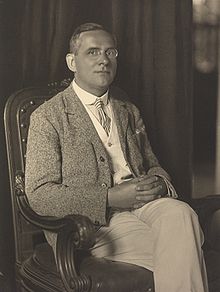Moritz Schlick
| Moritz Schlick | |
|---|---|

Moritz Schlick around 1930
|
|
| Born |
Friedrich Albert Moritz Schlick April 14, 1882 Berlin, German Empire |
| Died | June 22, 1936 (aged 54) Vienna, Austria |
| Alma mater |
University of Heidelberg University of Lausanne University of Berlin |
| Era | 20th-century philosophy |
| Region | Western Philosophy |
| School | Analytic philosophy, Logical Positivism, Vienna Circle |
|
Main interests
|
Logic, Philosophy of Science, Philosophy of Mathematics, Ethics |
|
Notable ideas
|
General theory of knowledge (observational statement) |
|
Influences
|
|
|
Influenced
|
|
Friedrich Albert Moritz Schlick (German: [ʃlɪk]; April 14, 1882 – June 22, 1936) was a German philosopher, physicist, and the founding father of logical positivism and the Vienna Circle.
Schlick was born in Berlin to a wealthy family, his father was Ernst Albert Schlick and his mother was Agnes Arndt. He studied physics at the University of Heidelberg, the University of Lausanne, and, ultimately, the University of Berlin under Max Planck. In 1904, he completed his dissertation essay, "Über die Reflexion des Lichts in einer inhomogenen Schicht" ("On the Reflection of Light in a Non-Homogeneous Medium"). After a year as Privatdozent at Göttingen, he turned to the study of Philosophy in Zurich. In 1907, he married Blanche Hardy In 1908, he published Lebensweisheit ("The Wisdom of Life"), a slim volume about eudaemonism, the theory that happiness is the highest ethical pursuit. His habilitation essay, "Das Wesen der Wahrheit nach der modernen Logik" ("The Nature of Truth According to Modern Logic"), was published in 1910. Several essays about aesthetics followed, whereupon Schlick turned his attention to problems of epistemology, the philosophy of science, and more general questions about science. In this last category, Schlick distinguished himself by publishing a paper in 1915 about Einstein's special theory of relativity, a topic only ten years old. He also published Raum und Zeit in der gegenwärtigen Physik ("Space and Time in Contemporary Physics"), which extended his earlier results by applying Poincaré's geometric conventionalism to explain Einstein's adoption of a non-Euclidean geometry in the General Theory of Relativity.
...
Wikipedia
